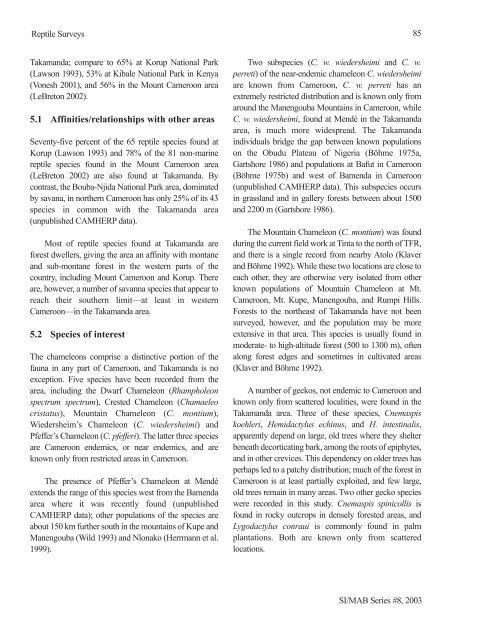Fisheries in the Southern Border Zone of Takamanda - Impact ...
Fisheries in the Southern Border Zone of Takamanda - Impact ...
Fisheries in the Southern Border Zone of Takamanda - Impact ...
You also want an ePaper? Increase the reach of your titles
YUMPU automatically turns print PDFs into web optimized ePapers that Google loves.
Reptile Surveys<br />
<strong>Takamanda</strong>; compare to 65% at Korup National Park<br />
(Lawson 1993), 53% at Kibale National Park <strong>in</strong> Kenya<br />
(Vonesh 2001), and 56% <strong>in</strong> <strong>the</strong> Mount Cameroon area<br />
(LeBreton 2002).<br />
5.1 Aff<strong>in</strong>ities/relationships with o<strong>the</strong>r areas<br />
Seventy-five percent <strong>of</strong> <strong>the</strong> 65 reptile species found at<br />
Korup (Lawson 1993) and 78% <strong>of</strong> <strong>the</strong> 81 non-mar<strong>in</strong>e<br />
reptile species found <strong>in</strong> <strong>the</strong> Mount Cameroon area<br />
(LeBreton 2002) are also found at <strong>Takamanda</strong>. By<br />
contrast, <strong>the</strong> Bouba-Njida National Park area, dom<strong>in</strong>ated<br />
by savana, <strong>in</strong> nor<strong>the</strong>rn Cameroon has only 25% <strong>of</strong> its 43<br />
species <strong>in</strong> common with <strong>the</strong> <strong>Takamanda</strong> area<br />
(unpublished CAMHERP data).<br />
Most <strong>of</strong> reptile species found at <strong>Takamanda</strong> are<br />
forest dwellers, giv<strong>in</strong>g <strong>the</strong> area an aff<strong>in</strong>ity with montane<br />
and sub-montane forest <strong>in</strong> <strong>the</strong> western parts <strong>of</strong> <strong>the</strong><br />
country, <strong>in</strong>clud<strong>in</strong>g Mount Cameroon and Korup. There<br />
are, however, a number <strong>of</strong> savanna species that appear to<br />
reach <strong>the</strong>ir sou<strong>the</strong>rn limit—at least <strong>in</strong> western<br />
Cameroon—<strong>in</strong> <strong>the</strong> <strong>Takamanda</strong> area.<br />
5.2 Species <strong>of</strong> <strong>in</strong>terest<br />
The chameleons comprise a dist<strong>in</strong>ctive portion <strong>of</strong> <strong>the</strong><br />
fauna <strong>in</strong> any part <strong>of</strong> Cameroon, and <strong>Takamanda</strong> is no<br />
exception. Five species have been recorded from <strong>the</strong><br />
area, <strong>in</strong>clud<strong>in</strong>g <strong>the</strong> Dwarf Chameleon (Rhampholeon<br />
spectrum spectrum), Crested Chameleon (Chamaeleo<br />
cristatus), Mounta<strong>in</strong> Chameleon (C. montium),<br />
Wiedersheim’s Chameleon (C. wiedersheimi) and<br />
Pfeffer’s Chameleon (C. pfefferi). The latter three species<br />
are Cameroon endemics, or near endemics, and are<br />
known only from restricted areas <strong>in</strong> Cameroon.<br />
The presence <strong>of</strong> Pfeffer’s Chameleon at Mendé<br />
extends <strong>the</strong> range <strong>of</strong> this species west from <strong>the</strong> Bamenda<br />
area where it was recently found (unpublished<br />
CAMHERP data); o<strong>the</strong>r populations <strong>of</strong> <strong>the</strong> species are<br />
about 150 km fur<strong>the</strong>r south <strong>in</strong> <strong>the</strong> mounta<strong>in</strong>s <strong>of</strong> Kupe and<br />
Manengouba (Wild 1993) and Nlonako (Herrmann et al.<br />
1999).<br />
Two subspecies (C. w. wiedersheimi and C. w.<br />
perreti) <strong>of</strong> <strong>the</strong> near-endemic chameleon C. wiedersheimi<br />
are known from Cameroon, C. w. perreti has an<br />
extremely restricted distribution and is known only from<br />
around <strong>the</strong> Manengouba Mounta<strong>in</strong>s <strong>in</strong> Cameroon, while<br />
C. w. wiedersheimi, found at Mendé <strong>in</strong> <strong>the</strong> <strong>Takamanda</strong><br />
area, is much more widespread. The <strong>Takamanda</strong><br />
<strong>in</strong>dividuals bridge <strong>the</strong> gap between known populations<br />
on <strong>the</strong> Obudu Plateau <strong>of</strong> Nigeria (Böhme 1975a,<br />
Gartshore 1986) and populations at Bafut <strong>in</strong> Cameroon<br />
(Böhme 1975b) and west <strong>of</strong> Bamenda <strong>in</strong> Cameroon<br />
(unpublished CAMHERP data). This subspecies occurs<br />
<strong>in</strong> grassland and <strong>in</strong> gallery forests between about 1500<br />
and 2200 m (Gartshore 1986).<br />
The Mounta<strong>in</strong> Chameleon (C. montium) was found<br />
dur<strong>in</strong>g <strong>the</strong> current field work at T<strong>in</strong>ta to <strong>the</strong> north <strong>of</strong> TFR,<br />
and <strong>the</strong>re is a s<strong>in</strong>gle record from nearby Atolo (Klaver<br />
and Böhme 1992). While <strong>the</strong>se two locations are close to<br />
each o<strong>the</strong>r, <strong>the</strong>y are o<strong>the</strong>rwise very isolated from o<strong>the</strong>r<br />
known populations <strong>of</strong> Mounta<strong>in</strong> Chameleon at Mt.<br />
Cameroon, Mt. Kupe, Manengouba, and Rumpi Hills.<br />
Forests to <strong>the</strong> nor<strong>the</strong>ast <strong>of</strong> <strong>Takamanda</strong> have not been<br />
surveyed, however, and <strong>the</strong> population may be more<br />
extensive <strong>in</strong> that area. This species is usually found <strong>in</strong><br />
moderate- to high-altitude forest (500 to 1300 m), <strong>of</strong>ten<br />
along forest edges and sometimes <strong>in</strong> cultivated areas<br />
(Klaver and Böhme 1992).<br />
A number <strong>of</strong> geckos, not endemic to Cameroon and<br />
known only from scattered localities, were found <strong>in</strong> <strong>the</strong><br />
<strong>Takamanda</strong> area. Three <strong>of</strong> <strong>the</strong>se species, Cnemaspis<br />
koehleri, Hemidactylus ech<strong>in</strong>us, and H. <strong>in</strong>test<strong>in</strong>alis,<br />
apparently depend on large, old trees where <strong>the</strong>y shelter<br />
beneath decorticat<strong>in</strong>g bark, among <strong>the</strong> roots <strong>of</strong> epiphytes,<br />
and <strong>in</strong> o<strong>the</strong>r crevices. This dependency on older trees has<br />
perhaps led to a patchy distribution; much <strong>of</strong> <strong>the</strong> forest <strong>in</strong><br />
Cameroon is at least partially exploited, and few large,<br />
old trees rema<strong>in</strong> <strong>in</strong> many areas. Two o<strong>the</strong>r gecko species<br />
were recorded <strong>in</strong> this study. Cnemaspis sp<strong>in</strong>icollis is<br />
found <strong>in</strong> rocky outcrops <strong>in</strong> densely forested areas, and<br />
Lygodactylus conraui is commonly found <strong>in</strong> palm<br />
plantations. Both are known only from scattered<br />
locations.<br />
85<br />
SI/MAB Series #8, 2003

















